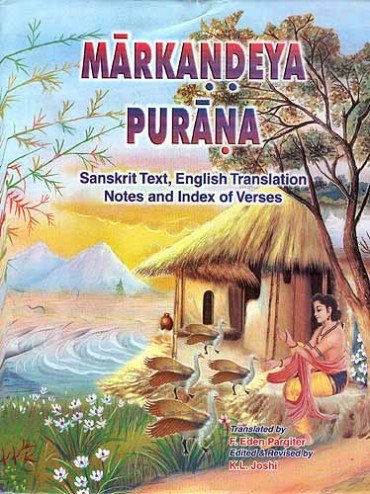The Markandeya Purana
by Frederick Eden Pargiter | 1904 | 247,181 words | ISBN-10: 8171102237
This page relates “the description of the earth (continued)” which forms the 59th chapter of the English translation of the Markandeya-purana: an ancient Sanskrit text dealing with Indian history, philosophy and traditions. It consists of 137 parts narrated by sage (rishi) Markandeya: a well-known character in the ancient Puranas. Chapter 59 is included the section known as “exposition of the manvantaras”.
Canto LIX - The description of the Earth (continued)
Mārkaṇḍeya tells of the continents Bhadrāśva and Ketumāla, and the country of the Northern Kurus, and describes their mountains, rivers and people.
Mārkaṇḍeya spoke:
Thus then have I declared this continent Bhārata accurately, O muni, and the Kṛta, Tretā, and Dvāpara, and Kali ages which are the four ages.[1] And now indeed there is a fourfold classification[2] in these ages, O brāhman. Four, three and two hundreds and one hundred of autumns men live here in the Kṛta, Tretā and two other ages respectively, O brāhman.
Hear from me of the continent Bhadrāśva, which is situated east of the magnificent eastern mountain Devakūṭa.
Both Śvetaparṇa, and Nīla, and the lofty mountain Śaivāla, Kaurañja, Parṇaśālāgra—these indeed are the five mountain ranges. There are many small mountains besides, which are offshoots of those ranges; the countries there are distinguished by them, they are of various shapes and occur in thousands. Moreover they are like white water-lilies and are auspicious with their pure summits. Such-like and diverse also are other hills by hundreds and thousands. The Śītā, the Śaṅkhāvatī, the Bhadrā, and the Cakrāvartā and many other rivers spread abroad there, bearing down volumes of cold water. In this country mankind are lustrous as shells and like pure gold;[3] they associate with the celestials; they are holy; their lives last a thousand years; neither inferior nor superior exists among them; they are all of equal appearance; they are endowed naturally with patience and the seven other good qualities.
And there the god Janārdana has a horse’s head and four arms; with head, chest, penis, feet and forearms resembling a horse's, and he has three eyes. And thus the objects of sense are perceptible by him, the lord of the world.
Now hear from me about the continent Ketumāla which is on the west.
Viśāla, Kambala, Kṛṣṇa, Jayanta, Hariparvata, Viśoka, and Vardhamāna—these seven are the mountain ranges. There are other hills by thousands, among which a multitude of people dwell. Those people dwell there in hundreds, the Maulis[4] huge in stature, the Śākas, Potas and Karambhakas,[5] and those who are distinguished by their thumbs,[6] who drink of the great rivers, the Yaṅkṣu, the Śyāmā, the Svakambalā, the Amoghā, the Kāminī, the Śyāmā, and of others in thousands. And here life is equal to the above-mentioned lives in Ehadrāśva. And here the adorable Hari wears a boar’s shape and resembles a boar in feet, face, chest, back and flanks. And the lunar constellations are beautiful in that country which enjoys three constellations only. Such is this continent of Ketumāla, which I have described to thee, O best of munis.
Next I will tell thee of the Northern Kurus; hearken to me now.
There the trees yield sweet fruit, they bear blossoms and fruit in constant succession; and they produce garments and ornaments inside their fruits; verily they bestow all one’s desire; they yield fruit according to all one’s desire. The ground abounds with precious stones; the air is fragrant and always delightful. Mankind are born there, when they quit the world of the gods. They are born in pairs; the pairs abide an equal time, and are as fond of each other as cakravākas. Their stay there is fourteen and a half thousands of years indeed. And Candrakānta is the chief of the mountains, and Sūryakānta is the next; they are the two mountain ranges in that continent. And in the midst thereof the great river Bhadrasomā flows through the earth with a volume of sacred and pure water. And there are other rivers by thousands in that northern continent; and some flow with milk and others flow with ghee. And there are lakes of curdled milk there, and others lie among the various hills. And fruits of various kinds, which taste rather like amṛta, are produced by hundreds and thousands in the woods in those continents. And there the adorable Viṣṇu has his head turned to the east and wears a fish’s shape. And the lunar constellations are divided[7] into nine parts, three and three, and the regions of the sky are divided into nine parts, O best of munis.
And in the ocean ate the islands Candrādvīpa, and next Bhadradvīpa; and there also within the ocean is the famous island Puṇya, O great muni.
Thus I have described this northern continent of Kuru, O brāhman. Hearken while I tell thee of Kimpuruṣa and the other continents.
Footnotes and references:
[1]:
For tatha-tiṣya-catuṣṭhayam read tathā tiṣya-catuṣṭayam.
[2]:
Catur-varṇyo, a masc. abstract noun.
[3]:
Śaṅkha-śuddha-hema-sama-prabhāḥ.
[4]:
This and the following words seem to be the names of people; mountains and rivers in these continents are named, and it seems most natural and reasonable to take these words as names.
[5]:
Śākapotaharambhakāḥ; or perhaps “Śā kas, Potakas and Rabhakas.”
[6]:
Aṅgula-pramukhāś.
[7]:
For vibhakto read vibhaktir?
